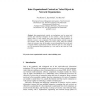Free Online Productivity Tools
i2Speak
i2Symbol
i2OCR
iTex2Img
iWeb2Print
iWeb2Shot
i2Type
iPdf2Split
iPdf2Merge
i2Bopomofo
i2Arabic
i2Style
i2Image
i2PDF
iLatex2Rtf
Sci2ools
CAISE
2006
Springer
2006
Springer
Inter-organisational Controls as Value Objects in Network Organisations
Inter-organizational controls are mechanisms used to ensure and monitor that networked enterprises do not commit a fraud and behave as agreed. Many of such controls have, apart from their control purpose, an inherent economic value component. This feature requires controls to pop-up into business value models, stating how actors create, trade and consume objects of economic value. In this paper, we provide guidelines that can be used to decide whether organizational controls should be part of a value model or not. We demonstrate these guidelines by a case study on the Letter of Credit procedure.
| Added | 20 Aug 2010 |
| Updated | 20 Aug 2010 |
| Type | Conference |
| Year | 2006 |
| Where | CAISE |
| Authors | Vera Kartseva, Jaap Gordijn, Yao-Hua Tan |
Comments (0)

